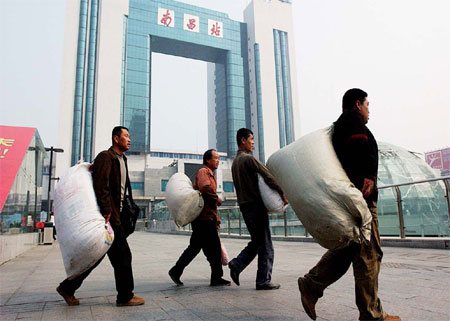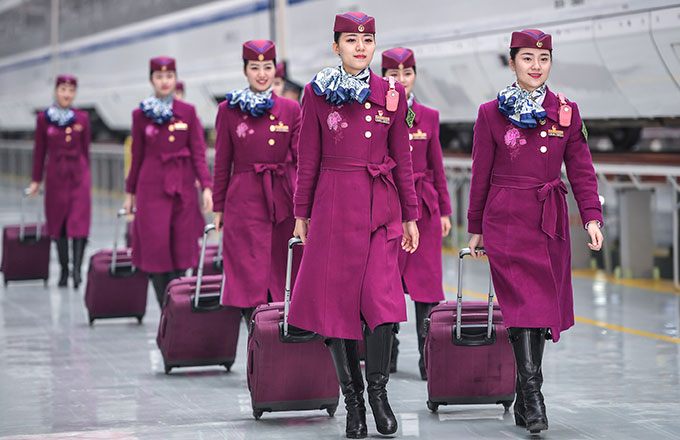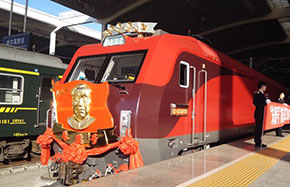Urban-rural divide near top of agenda
|
Migrant workers walk past the Nanchang railway station in Jiangxi province in this file photo. The Third Plenum of the 18th Central Committee of the Communist Party of China is likely to give a new impetus to urbanization in China. Provided to China Daily |
Plenum may stress on the need for more coordinated efforts between ministries, local governments
Urbanization is one of the key areas in which the Third Plenary Session of the 18th Central Committee of the Communist Party of China that begins on Nov 9 is likely to have a profound impact for many years to come.
The country's new leadership, at its economic work conference last December, agreed on urbanization as a new focus for growing the economy. The importance of adopting new ways to maintain growth has been underlined by the fall in exports brought on by the global economic crisis.
The country has steadily urbanized over the past 35 years. A mere 17.9 percent of the population lived in cities in 1979, a figure that by last year had climbed to 52.6 percent. That has been accompanied by an almost 100-fold increase in personal gross domestic product, from 381 yuan in 1978 to 37,170 yuan ($6,100; 4,500 euros) last year.
However, only 27 percent of the population have urban residence permits, or hukou, to which welfare rights are attached, and more than 300 million migrant workers live in cities without hukou.
Although China has a basic social security network nationwide, the welfare gap between an urban hukou holder and one from the country remains so large that local governments cannot afford to offer all migrant workers hukou anytime soon.
An overabundance of labor on the land is not the result of mechanization, but of the simple fact that too many people are living in the country. Farm economics in the Chinese countryside, featuring small plots and intensive human input, are still years behind modern farming in developed countries.
At the same time, it is infrastructure construction businesses and low-level manufacturing and services businesses that account for the bulk of large urban employers. For migrant workers, a lack of education and training, their marginalized social status and their isolated living make it hard for them to integrate into the urban community.
After the central government abolished agricultural land tax in 2006, some migrant workers opted to leave their small plots uncultivated rather than rent them out because of the absence of a functional land transfer market.
China's urbanization has been propelled by the artificial divide between city and country. The hukou system, which essentially codifies the agricultural population's low status, is the main barrier to healthy urbanization. In fact, some local governments see urbanization first and foremost as a way of giving economic growth a spurt, neglecting the fact that improving public services and making them available to all are essential if urbanization is to be successful.
Gao Guoli, an economics researcher with the National Development and Reform Commission, said recently that China's urbanization is characterized by three things: slow industrialization, fast urbanization of land, and speed being given priority over quality.
China can draw lessons from Latin America, where 79.6 percent of people live in cities, compared with 72.08 percent in Europe. However, industrialization is much lower in Latin America than in Europe. In Latin America, many rural dwellers have abandoned their villages only to create villages within cities.
In contrast, urbanization in the United States, where 85 percent of people live in cities, has its roots in the well-coordinated growth of agriculture and industry.
One message that is expected to be heavily stressed at the Third Plenum is that government officials should not treat urbanization simply as a tool for boosting domestic consumption, but see it as the logical result of greater agricultural and industrial efficiency.
"The coming decade will be crucial for urbanization," says Zhang Monan, an economics researcher with the State Information Center. "Investing in Keynesian urbanization is not guaranteed to deliver China sustainable growth in GDP. The fundamental influence of urbanization does not lie in expanding demand at home."
The plenum is likely to lay out the direction of reforms related to urbanization and to come up with ways to ensure that the efforts of ministries and local governments are well coordinated.
In June, the National Development and Reform Commission said the central government will overhaul hukou rules covering jurisdictions large and small, giving much greater flexibility to the system, and making it easier for country dwellers to obtain town and city hukou.
But that will mean local governments will have to find new revenue to pay for welfare that the new urban dwellers will be entitled to.
A document made public by the Development Research Center of the State Council on Oct 26, and which is expected to form the basis of the plenum's final communique, says local governments should raise new revenue through property, resource, environmental and consumption taxes.
The plan suggests the central government pay for a basic pension for all citizens and public services used by the migrant population, which would greatly ease local governments' fiscal burden.
Acquiring farmers' land for meager compensation, then selling the land for development has become a favored way for China's local governments to raise revenue, resulting in ghost cities springing up all over the country.
Gao says the national urban area more than trebled between 1996 and 2011, but the urban population rose from 300 million to only 690 million.
The challenge before the Third Plenum is to build a unified land transfer market based on individual farmer's land ownership. The Third Plenum of the 17th CPC Central Committee five years ago said farmers would be given the right to dispose of their land in a legal framework and have the right to benefit from the rise in land values.
Capable farmers and agricultural companies would be able to integrate small plots into large farms, giving farmers better incomes and thus more choices, including with their careers and education.
Urbanizing small and middle-level cities is seen as a way not only of easing population pressures on large and super-large cities, but of giving a fillip to balanced industrial and employment growth nationwide.
There are 2,816 small and middle-level cities in China with populations of less than 1 million, and they account for 84.5 percent of the national economy, but recent research by the Northeast Asia Development Research Institute in Beijing shows that at the regional level only 35.1 of the population live in big towns and cities.
Zheng Xinli, an economics researcher at the China Center for International Economy Exchanges in Beijing, says: "Whether the welfare gap between farmers and big-city dwellers can be closed over the next 10 to 20 years depends on the development of county economies and small and middle-level cities."
China's urbanization is also being seen as important to the world at large. The World Bank President, Jim Yong Kim, has said research on the country's urbanization is valuable for other developing countries.



















